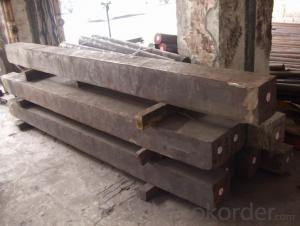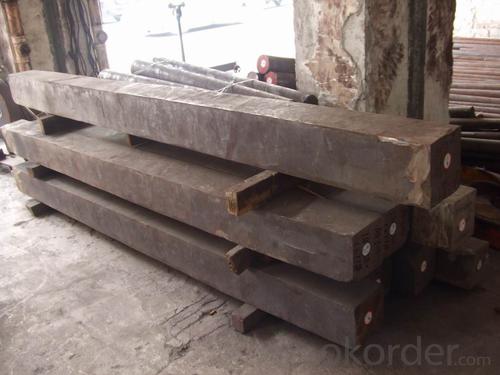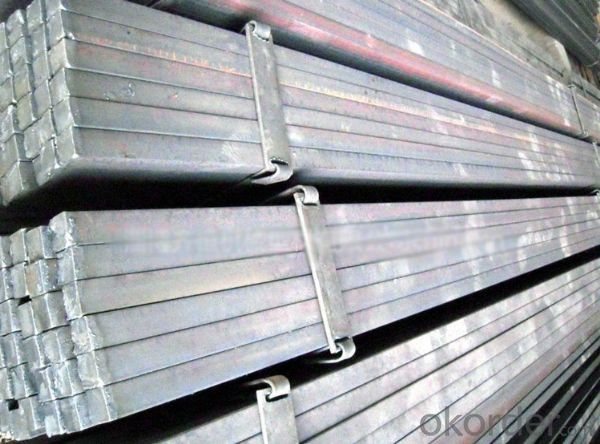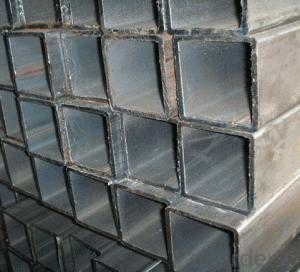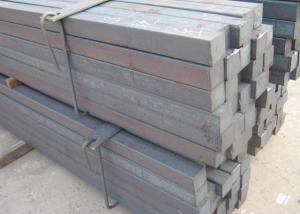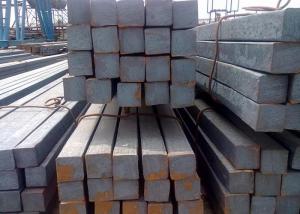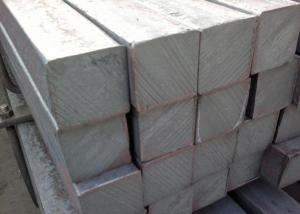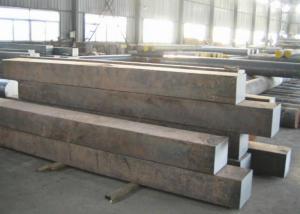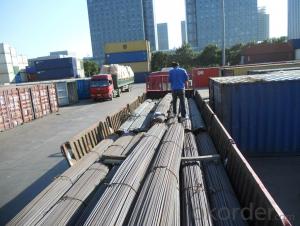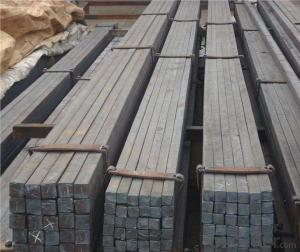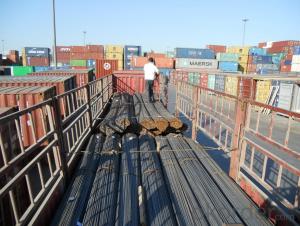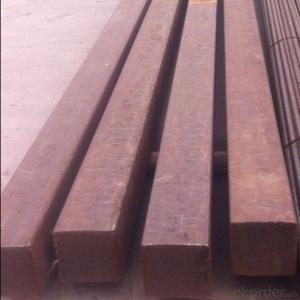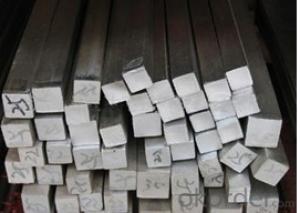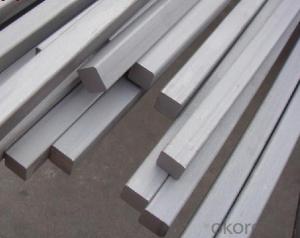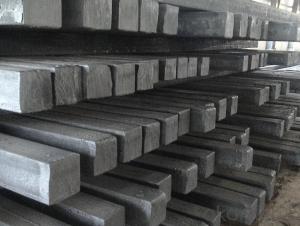14mm*1.54kg/m square bar for construction
- Loading Port:
- Tianjin
- Payment Terms:
- TT OR LC
- Min Order Qty:
- 25 m.t.
- Supply Capability:
- 100000 m.t./month
OKorder Service Pledge
OKorder Financial Service
You Might Also Like
Product Description:
There are two types of Square Bar, one is hot rolled square bar and other one is cold drawn square bar. Our principal products is hot rolled square bar. We dedicate to products with material Q195 and Q235. We offer products with high quality and low price.
Specifications of Hot-rolled Square Steel Bar:
-Standard: GB,
-Grade: Q195/Q235 or equivalent.
-Chemical Composition:
Standard | Grade | Element (%) | ||||
C | Mn | S | P | Si | ||
GB | Q195 | 0.06~0.12 | 0.25~0.50 | ≤0.050 | ≤0.045 | ≤0.30 |
GB | Q235B | 0.12~0.20 | 0.30~0.70 | ≤0.045 | ≤0.045 | ≤0.30 |
-Mechanical Properties:
Mechanical Properties | Grade | Steel diameter(mm) | |||
≤16 | 16~40 | 40~60 | 60~100 | ||
Yield Point Δs/MPa | Q195 | ≥195 | ≥185 | - | - |
Q235 | 235 | 225 | 215 | 205 | |
Tensile Strength | Q195 | 315~390 | |||
Q235 | 375~500 | ||||
Elongation δ5% | Q195 | ≥33 | ≥32 | - | - |
Q235 | 26 | 25 | 24 | 23 | |
Measures of Hot-rolled Square Steel Bar (Big measures):
(Section of Hot-rolled Square Steel Bar)
-Length of a side and Theoretical weight of Square Bar (Big measures).
Length of a side(mm) | Theoretical weight(kg/m) | Length of a side(mm) | Theoretical weight(kg/m) |
53 | 22.05 | 80 | 50.24 |
56 | 24.61 | 85 | 56.72 |
60 | 28.26 | 90 | 63.59 |
63 | 31.16 | 95 | 70.85 |
70 | 38.49 | 100 | 78.50 |
75 | 44.16 |
Notes:
1, The theoretical weights in the list, base on the density of 7.85 g/cm3.
2, Formula for theoretical weight of Square bar: a(length of a side) * a * 0.00785
3, The numbers with *mean that they are not regular or we don’t offer them.
-Regular length of Square Bar:
Steel | Length of a side (mm) | Length of steel (m) |
Normal steel | < 25 | 4~10 |
> 25 | 3~9 | |
Steel of high quality | All measure | 2~6 |
Tool steel >75 | 1~6 |
Usage/Applications of Hot-rolled Square Steel Bar:
-The Square Steel is normally used as structure steel.
-Row material for other structure steel like steel angles, channels, I-beams, H-beams, etc…
-Row material for steel pipes.
Packaging & Delivery of Hot-rolled Square Steel Bar:
-Packing Detail:
1, The products can be packed in bundles by steel wires.
2, The weight of each bundle no exceed normally 3 tons.
-Marks: We make tag marks and color marks for each bundle. The tag marks with white background and red company log will be tied up to each bundle. The information is usually including basic information of company and products like product name, specification, etc...and other information required by customers. As for color marks, we will paint both ends of each bundles to make sure that it will be more convenient for customers to distinguish theme from other products.
-Delivery Detail: 30~45 working days after receive buyer’s T.T. or L/C.
Payment:
-Invoicing on theoretical weight or actual weight as customer’s request.
-FOB, CFR or CIF.
-Regular terms of payment:
1, 30% payment in advance, the remaining balance (70% payment) against the copy of B/L.
2, 30% payment in advance, the remaining balance (70% L/C) against the copy of B/L.
3, Negotiable.
-The payment terms will be written in contraction detailedly
- Q: How do you use a steel square to lay out a pentagon?
- In order to lay out a pentagon using a steel square, a specific set of steps must be followed. Below is a guide to assist you in this process: To begin, you must determine the desired size of the pentagon. It is necessary to know either the length of one side or the apothem (the distance from the center to any side). Next, place your steel square on a flat surface, ensuring proper alignment. Measure the desired length of one side of the pentagon on the blade of the steel square. Use a pencil or any suitable marking tool to mark this measurement. Position the blade of the square at the desired starting point for the construction of the pentagon. Make sure that the marked measurement aligns precisely with the starting point. Hold the steel square securely in place and pivot it around the starting point, creating an arc. Repeat the previous step by pivoting the square around the endpoint of the arc, creating another arc that intersects the first one. Continue this process, pivoting the square along the intersecting arcs, until you have five intersecting arcs. Connect the points where the arcs intersect to form the sides of the pentagon. Once the sides of the pentagon are marked, double-check the angles to ensure that they all measure 108 degrees. Make any necessary adjustments. Finally, use a ruler or straight edge to connect the marked points, thus forming the complete pentagon shape. The process of using a steel square to lay out a pentagon demands precision and meticulous measurements. By following these steps, you will be able to construct a pentagon accurately using this versatile tool.
- Q: Can a steel square be used for checking the levelness of a ceiling?
- No, a steel square cannot be used for checking the levelness of a ceiling. A steel square is a measuring tool typically used in carpentry for marking and measuring angles. It is not designed or calibrated for checking the levelness of surfaces. To check the levelness of a ceiling, a spirit level or a laser level would be more appropriate tools. These tools are specifically designed for this purpose and provide accurate measurements to ensure a level surface.
- Q: Can a steel square be used for measuring the height of a ladder?
- Using a steel square for measuring the height of a ladder is not feasible. A steel square, which is also called a framing square or carpenter's square, is mainly employed in carpentry and woodworking to take measurements and mark lines. It comprises a 90-degree angle and a shorter 45-degree angle. Although it is adaptable, it is not intended for measuring vertical distances such as ladder height. To determine the height of a ladder, it is customary to use a tape measure or a specialized extendable measuring rod created explicitly for this task.
- Q: How do you use a steel square to lay out a stair stringer?
- In order to lay out a stair stringer using a steel square, the following steps should be followed: 1. Collect the necessary tools: a steel square, a tape measure, a pencil, a framing square, and a saw. 2. Begin by determining the total rise of the stairs. Measure the vertical distance from the finished floor at the bottom to the finished floor at the top of the stairs. This measurement will establish the required number of risers. 3. Establish the desired height for each riser. Building codes generally mandate a riser height ranging from 6 to 8 inches. Divide the total rise by the desired riser height to calculate the number of risers needed. 4. Subsequently, ascertain the tread depth. Building codes typically demand a tread depth between 9 and 11 inches. Measure the horizontal distance between the finished floor at the bottom and the finished floor at the top of the stairs. Divide this measurement by the number of treads to determine the tread depth. 5. Position the framing square on the edge of the stringer, aligning the heel of the square with the bottom of the stringer and the blade with the tread depth measurement. Proceed to mark a line along the blade of the square. 6. Shift the square up to the top of the stringer, aligning the heel with the top and the blade with the riser height measurement. Proceed to mark a line along the blade of the square. 7. Connect the two lines marked on the stringer to outline the shape of the stringer. Utilize a straight edge to ensure the lines are straight and perpendicular. 8. Repeat this procedure for the desired number of stringers, usually two for a standard staircase. 9. Employ a saw to cut along the lines marked on the stringer, thereby creating the stair stringer. By adhering to these steps and utilizing a steel square, one can accurately lay out a stair stringer and guarantee the construction of a secure and properly aligned staircase.
- Q: Can a steel square be used for checking the squareness of window frames?
- Yes, a steel square can be used for checking the squareness of window frames. A steel square is a versatile tool commonly used in woodworking and construction to ensure accuracy and squareness. It consists of a steel blade with a 90-degree angle at one end and a handle at the other. By placing the steel square against the window frame, one can check if the corners are perfectly perpendicular or if there is any deviation from a right angle. If the steel square does not align properly with the corners, adjustments can be made to ensure the window frame is square before installation.
- Q: Can a steel square be used for roofing projects?
- Indeed, roofing projects can make good use of a steel square. Known as a framing square or carpenter's square, this versatile tool serves multiple purposes in construction and carpentry, including roofing. It proves handy when it comes to measuring, marking, and cutting angles for roof framing, as well as determining pitch and slope. Thanks to its right angles and diverse measurements, a steel square guarantees accurate and precise cuts and measurements throughout roofing endeavors. Moreover, these squares are generally sturdy and resistant to corrosion, making them a fitting choice for outdoor use in roofing applications.
- Q: How do you use a steel square for marking compound angles?
- To use a steel square for marking compound angles, you need to first determine the desired angle and adjust the square accordingly. Then, position the square on the material and align it with the reference edge. Finally, trace along the square's edge to mark the compound angle accurately.
- Q: What are the markings and graduations on a steel square used for?
- The utilization of the markings and graduations on a steel square encompasses a multitude of purposes within the realm of carpentry and its related fields. In the first place, these markings serve the function of measuring and delineating specific lengths on the material undergoing manipulation. It is customary for the square to possess both imperial and metric measurements, thereby facilitating meticulous and precise calculations in either measurement system. These markings play a pivotal role in guaranteeing that cuts and joints are executed with the utmost accuracy, ultimately culminating in a more refined and professional outcome. Furthermore, the graduations adorning a steel square find utility in the measurement of angles. Typically, the square is equipped with a protractor scale, which permits the determination of angles ranging from 0 to 180 degrees. This feature proves particularly advantageous when confronted with tasks such as the generation of angled cuts or the demarcation of specific angles for the purpose of joinery work. Moreover, the steel square frequently encompasses supplementary markings and characteristics that enhance various undertakings. For instance, it may incorporate a scale designated for locating the center of a circle, or a ruler edge designed to expedite swift measurements. Some squares even incorporate scribe lines, which can be employed for marking parallel lines or referencing points. All in all, the markings and graduations on a steel square represent indispensable tools for the attainment of precise measurements, angle demarcations, and a myriad of other duties within the realm of carpentry and its associated fields. Their presence ensures the achievement of exactitude and efficiency, ultimately yielding workmanship of superior quality.
- Q: Can a steel square be used for furniture-making projects?
- Indeed, furniture-making projects can utilize a steel square. Woodworkers and furniture makers frequently employ steel squares to precisely gauge and designate angles, corners, and straight lines. These adaptable tools serve various purposes, including verifying joint squareness, outlining mortise and tenon joints, and guaranteeing accurate cuts and joinery. Due to their durability and ability to yield precise measurements, steel squares prove invaluable in furniture-making endeavors.
- Q: How do you use a steel square to find the square footage of a roof?
- To use a steel square to find the square footage of a roof, you would need to measure the length and width of each roof section using the square's measurements. Multiply the length by the width for each section, and then sum up the individual areas to find the total square footage of the roof.
Send your message to us
14mm*1.54kg/m square bar for construction
- Loading Port:
- Tianjin
- Payment Terms:
- TT OR LC
- Min Order Qty:
- 25 m.t.
- Supply Capability:
- 100000 m.t./month
OKorder Service Pledge
OKorder Financial Service
Similar products
Hot products
Hot Searches
Related keywords
